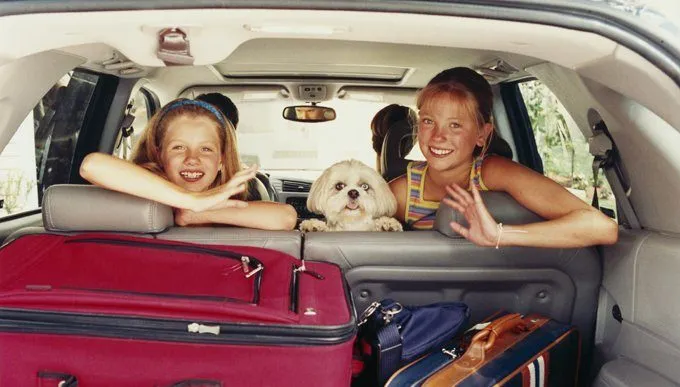Canine car sickness can be relieved by following a few simple steps to make your furry friend’s travel more comfortable. By creating a calming environment, using medications and natural remedies, and gradually acclimating your dog to car rides, you can help prevent and alleviate car sickness symptoms.
Car sickness can be a common issue for dogs, causing symptoms such as vomiting, drooling, and restlessness. Understanding the causes and implementing these strategies can make car travel enjoyable for both you and your four-legged companion. Whether you’re planning a short trip to the vet or a long road trip, these tips will help keep your dog happy and healthy on the go.

Credit: dogtime.com
Understanding Canine Car Sickness
Car rides with your furry friend can be a fun and exciting adventure, but when your dog starts experiencing car sickness, it can quickly turn into a challenging situation. Canine car sickness is a common problem faced by many pet owners, and it can be distressing for both the dog and the owner. This form of motion sickness is similar to what humans experience and can make travel uncomfortable and stressful for your beloved canine companion. However, understanding the causes, symptoms, and risk factors associated with canine car sickness can help you find effective ways to manage and alleviate the issue.
Causes Of Canine Car Sickness
There are several factors that can contribute to canine car sickness:
- Motion Sensitivity: Dogs with sensitive inner ear structures, which are responsible for maintaining balance, are more prone to car sickness.
- Anxiety and Fear: If your dog has a history of anxiety or fear associated with car rides, it can further trigger car sickness.
Symptoms Of Canine Car Sickness
Identifying the symptoms of canine car sickness is essential in order to provide your dog with the necessary care and comfort:
- Excessive Drooling: If your dog drools excessively during car rides, it could be a sign of car sickness.
- Vomiting or Nausea: Frequent retching, heaving, or actual vomiting may point towards your dog experiencing car sickness.
- Restlessness and Whining: If your dog appears restless, anxious, or exhibits unusual whining during car rides, it could be due to car sickness.
Factors That Increase The Risk Of Canine Car Sickness
Several factors can heighten the risk of your dog developing car sickness:
- Age and Breed: Puppies and younger dogs, as well as certain breeds known for their sensitivity to motion, are more susceptible to car sickness.
- Poor Ventilation: Lack of fresh air circulation within the car can contribute to the onset or worsening of car sickness symptoms in dogs.
- Intense Visual Stimulation: Continuous exposure to fast-moving scenery or frequent changes in visuals outside the car windows can trigger car sickness in dogs.
Preventing Canine Car Sickness
Canine car sickness can put a damper on road trips or even short drives with your beloved furry friend. But fear not, there are steps you can take to prevent this unpleasant experience for your dog. By gradually exposing them to car rides, ensuring proper ventilation and temperature control, and creating a comfortable environment, you can significantly reduce the chance of car sickness in your canine companion.
Gradual Exposure To Car Rides
One of the most effective ways to prevent canine car sickness is to gradually expose your dog to car rides. Start by simply sitting in the car with your dog, allowing them to become familiar with the environment. After a few sessions, progress to short drives around the block, gradually increasing the duration and distance over time.
By taking this step-by-step approach, your dog will gradually become accustomed to the motion and sensations associated with car travel, reducing the likelihood of car sickness. Remember to praise and reward your dog for their calm behavior during each session, reinforcing positive associations with car rides.
Proper Ventilation And Temperature Control
Ensuring proper ventilation and temperature control within the car is essential to prevent dog car sickness. Dogs are sensitive to changes in temperature and poor air quality, which can contribute to their discomfort and nausea during car rides.
To maintain adequate ventilation, it is recommended to keep the windows slightly cracked open, allowing fresh air to circulate throughout the vehicle. This promotes proper airflow and helps prevent stagnant air that may increase the likelihood of car sickness.
Additionally, maintaining a comfortable temperature inside the car is crucial. Avoid extreme heat or cold, as these can trigger discomfort in your dog. If necessary, consider using sunshades for the windows or even investing in a car temperature control system to ensure a pleasant environment for your furry companion.
Creating A Comfortable Environment For The Dog
Creating a comfortable environment inside the car can go a long way in preventing canine car sickness. Start by providing a familiar and cozy spot for your dog to sit or lie down during the ride. Whether it’s a designated dog bed, a soft blanket, or a travel crate, make sure your dog feels secure and comfortable in their space.
Another factor to consider is minimizing distractions within the car. Dogs can easily become overwhelmed by excessive noise, movements, or visual stimuli, which may contribute to car sickness. Keep the car ride calm and stress-free by reducing distractions, such as loud music, sudden braking, or erratic driving.
Finally, avoid feeding your dog a large meal before the car ride. A full stomach can increase the likelihood of nausea and vomiting. Instead, offer a small, light snack a few hours before the trip to help settle their stomach.
By gradually exposing your dog to car rides, ensuring proper ventilation and temperature control, and creating a comfortable environment, you can significantly reduce the chances of your furry friend experiencing car sickness. Remember to be patient and consistent in your efforts, and soon your dog will be eagerly hopping into the car, ready for new adventures without the fear of car sickness.
Treatment Options For Canine Car Sickness
If your canine companion struggles with car sickness, there are treatment options available to help alleviate their discomfort. From desensitization training to medications prescribed by a veterinarian, you have options to tackle this issue and make car rides a more enjoyable experience for your furry friend.
Medications For Canine Car Sickness
When it comes to treating canine car sickness, medications can be a viable option. There are several over-the-counter and prescription medications that can help alleviate the symptoms and make your furry friend’s car rides more enjoyable. Always consult with your veterinarian before starting any medication to ensure it is safe and appropriate for your dog’s specific needs. One popular medication option is diphenhydramine (Benadryl), which can help reduce nausea and motion sickness in dogs. The recommended dosage for dogs is 1 mg per pound of body weight, given orally 30 minutes before the car ride. It’s important to note that Benadryl may cause drowsiness, so make sure your dog is comfortable and secure during the car journey. Another commonly used medication is meclizine (Bonine), which is available in both prescription and over-the-counter forms. Meclizine works by preventing motion sickness and can be given to dogs 12.5 mg to 25 mg, depending on their weight, one hour before travel. If your pup experiences severe car sickness, your veterinarian might prescribe prescription medications specifically designed to treat motion sickness in dogs. These medications may include corticosteroids, which can help reduce inflammation and nausea, and antihistamines that have a sedative effect to calm anxiety and minimize motion sickness symptoms.Natural Remedies For Canine Car Sickness
If you prefer a more natural approach to treating your dog’s car sickness, there are several remedies you can try. These natural remedies can provide relief for your dog without the potential side effects of medications. Remember to consult with your veterinarian before starting any new natural supplements or remedies. Ginger is a common natural remedy that has been used for centuries to treat nausea and motion sickness. You can give your dog a small piece of fresh ginger in their food or offer ginger treats specifically formulated for dogs. Alternatively, there are ginger supplements available that can be administered prior to car rides. Another natural remedy to consider is Peppermint, which can help soothe the digestive system and alleviate nausea. You can give your dog a few drops of peppermint essential oil diluted with water, or you can find peppermint treats or supplements designed for dogs. CBD oil is gaining popularity as a natural remedy for various ailments, including car sickness in dogs. CBD can help reduce anxiety and promote a sense of calm, making car rides less stressful for your furry friend. It’s important to choose a high-quality CBD oil specifically designed for pets and follow the recommended dosage provided by the manufacturer. In conclusion, both medications and natural remedies can provide relief for canine car sickness. It’s essential to consult with your veterinarian to determine the best treatment option for your furry friend. Whether you opt for medications or natural remedies, helping your dog overcome car sickness will ensure more enjoyable car rides together.
Credit: www.pinterest.com
Training And Conditioning For Car Rides
If you’ve ever experienced the unpleasantness of your canine companion getting car sick, you know how distressing it can be. Fortunately, there are steps you can take to help desensitize your dog to car rides and make the experience more enjoyable for both of you. Training and conditioning your dog to ride in the car can help reduce anxiety and motion sickness. In this section, we’ll explore two techniques that can help achieve this – desensitizing the dog to car rides and positive reinforcement techniques.
Desensitizing The Dog To Car Rides
Desensitizing your dog to car rides involves gradually exposing them to the car environment in a positive and controlled manner. Here’s a step-by-step approach to help your furry friend become more comfortable with car rides:
- Start by bringing your dog near the car without actually getting inside. Allow them to sniff and explore the car from the outside.
- Once your dog seems relaxed around the car, open the car doors and let them peek inside. You can use tasty treats or their favorite toy to make the experience more enjoyable.
- Next, encourage your dog to jump into the car on their own volition by placing treats or toys inside the vehicle.
- Once your dog is comfortable jumping in and out of the car willingly, progress to shutting the car doors and rewarding them for remaining calm and relaxed.
- Finally, take short drives around the block, gradually increasing the duration as your dog becomes more accustomed to the motion and environment of the car.
Remember, this process requires patience and can take time. It’s important to go at your dog’s pace and never force them into a situation they are uncomfortable with. By gradually desensitizing your dog, you can help reduce their fear and anxiety associated with car rides.
Positive Reinforcement Techniques For Car Rides
Using positive reinforcement techniques can play a significant role in making car rides a positive experience for your dog. Here are some tips to help reinforce positive associations with car rides:
- Use treats, praise, and petting to reward your dog for calm behavior in the car. Positive reinforcement can help shift their focus away from anxiety and motion sickness.
- Start with short car rides and gradually increase the duration as your dog becomes more comfortable. Reward them with treats and praise at the end of each successful trip.
- Make the car a pleasant environment by using familiar blankets or toys that your dog associates with comfort and security.
- Keep the atmosphere calm and peaceful during car rides. Soft music or white noise can help soothe your dog and minimize stress.
- If your dog shows signs of anxiety or motion sickness during the journey, provide immediate reassurance and comfort. Avoid scolding or punishment, as this can reinforce negative associations with car rides.
By using positive reinforcement techniques, you can help your dog develop a positive attitude towards car rides, reducing the likelihood of car sickness and anxiety.
Tips For Traveling With A Canine Car Sickness-prone Dog
Traveling can be a stressful experience for both humans and dogs, especially if your furry friend is prone to car sickness. However, with a little preparation and some helpful tips, you can make the journey a much smoother and more enjoyable one. In this article, we’ll discuss three key strategies to help you travel with a canine car sickness-prone dog: choosing the right time to travel, preparing the dog for the trip, and incorporating regular breaks and motion sickness relief.
Choosing The Right Time To Travel
Timing is crucial when it comes to traveling with a dog that suffers from car sickness. By selecting the optimal time to hit the road, you can minimize the chances of your canine companion feeling queasy during the journey. Consider the following factors:
- Avoid feeding your dog before the trip: It’s best not to give your pup a big meal just before setting off. Ideally, you should feed your canine friend at least three to four hours before the journey to allow their stomach to settle.
- Travel during a calm period: If your pup gets anxious or stressed easily, it’s important to choose a time when there is less traffic or noise. Try to avoid rush hour or busy periods to create a more peaceful environment for your dog.
Preparing The Dog For The Trip
Proper preparation plays a vital role in minimizing car sickness for your furry friend. Here are a few key steps to take before hitting the road:
- Acclimate your dog to the car: Gradually introduce your dog to the car environment by taking short trips around the block or to nearby places they enjoy. This will help them build positive associations with car travel and reduce their anxiety.
- Create a comfortable and secure space: Make sure your dog has a cozy spot in the car, such as a familiar blanket or bed. You can also use a dog crate or harness to secure them safely during the journey, reducing their chances of feeling nauseous.
- Consult with a veterinarian: If your dog’s car sickness persists or worsens despite your efforts, it’s advisable to consult with a veterinarian. They may be able to prescribe medications or provide additional recommendations to help alleviate your pup’s discomfort.
Regular Breaks And Motion Sickness Relief
During long car journeys, regular breaks and motion sickness relief techniques can be incredibly beneficial for dogs prone to car sickness. Consider the following strategies:
| Take frequent breaks: | Plan frequent pit stops to allow your dog to stretch their legs, have a bathroom break, and get some fresh air. This will help reduce their anxiety and prevent motion sickness. |
| Offer small, light meals: | Instead of feeding your dog a full meal before traveling, give them small, light snacks during breaks. This will prevent their stomach from being too full and reduce the chances of car sickness. |
| Consider motion sickness medications: | If all else fails and your dog continues to experience car sickness, consult your veterinarian about motion sickness medications that may be suitable for your furry friend. |
By following these tips for traveling with a canine car sickness-prone dog, you can help alleviate their discomfort and ensure a more pleasant journey for everyone involved. Remember, a little preparation and some extra care can go a long way in making car travel a positive experience for your furry companion.

Credit: www.cnn.com
Frequently Asked Questions For Canine Car Sickness: Here’s What You Can Do About It
What Can I Do For My Dog That Gets Car Sick?
To help a dog that gets car sick, try these tips: Limit food before traveling. Use a comfortable crate or seat belt harness. Keep the car well-ventilated and take frequent breaks. Gradually desensitize your dog to car rides. Consult with a veterinarian for specific advice.
The goal is to make the ride as smooth and stress-free as possible.
What Is The Best Motion Sickness Medicine For Dogs?
The best motion sickness medicine for dogs varies. Consult a veterinarian for recommendations. Proper dosage must be administered based on the dog’s weight and condition.
Is Benadryl Good For Dogs With Car Sickness?
Benadryl can be helpful for dogs with car sickness. It can help relieve symptoms like nausea and vomiting. However, always consult with your vet first to ensure the proper dosage and to make sure it’s safe for your dog.
How Long Does It Take For A Dog To Recover From Car Sickness?
Dogs usually take a few weeks to recover from car sickness. Gradual exposure to car rides helps.
Conclusion
Canine car sickness can be a challenging problem for dog owners to deal with. However, there are several effective strategies that can help alleviate symptoms and improve your furry friend’s travel experience. From acclimatizing your dog to car rides and providing a comfortable environment to using medications or natural remedies, there are various options to explore.
Remember, every dog is different, so it may take some trial and error to find the right solution. With patience, consistent training, and a little extra care, you can help your pup overcome car sickness and enjoy stress-free journeys together.

